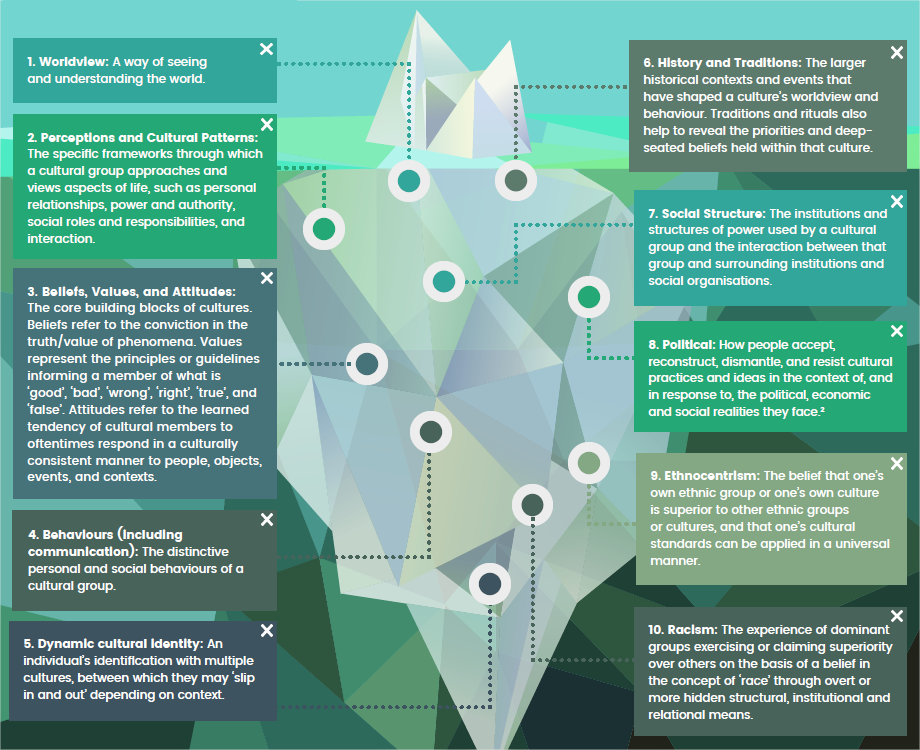The ability to recognise and understand your own cultural context is seen as an essential prerequisite for understanding and interacting with people from different
cultural backgrounds. Let’s begin by grappling with the idea of culture itself.
This module examines the highly nuanced, multi-dimensional, and dynamic nature of the concept of culture. The concept of culture is contested1, as it can mean different things to different people and in different contexts. Part of the difficulty in arriving at a comprehensive definition stems from the fact that when talking about culture we are usually referring to a rather limited ‘visible’ dimension (such as language, works of art, dress, etc.), and not necessarily considering the rather large ‘invisible’ area of concepts and ideas (such as values, attitudes, and worldviews).
An iceberg is often used as a metaphor for culture; on the surface we are able to see the more obvious aspects of culture, however, there are many aspects that lie deeper
and require time and critical thinking to comprehend.

vimeo.com/250718899
Common misconceptions of culture can be created by using definitions that limit understandings of culture to discrete and readily identifiable categories.1
Consider these three different ways of defining culture:
… the eight major factors which set groups apart from one another, and which give individuals and groups elements of identity: age, class, race, ethnicity, levels of ability, language, spiritual belief systems, educational achievement, and gender differences.3
… an abstract concept that refers to learned and shared patterns of perceiving and adapting to the world. Culture is reflected in its products: the learned, shared beliefs,
values, attitudes, and behaviors that are characteristic of a society or population. Culture is not a static phenomenon; it is dynamic and ever-changing, but it maintains a sense of coherence.4
Culture in its widest sense can be understood as a specific way of thinking, acting and feeling about one’s own actions and the actions of others. This includes conscious or underlying explanations of the world and one’s own and other people’s place within it. It also encompasses beliefs, faiths, ideologies and worldviews, which we call upon to assert reality, truths, values and ideas of good and bad. Culture as a group phenomenon develops further and changes according to changes in society. Culture as the property of an individual is open to further development depending on knowledge and experience.5
What do you notice about these three definitions of culture?
What are the differences and similarities in the definitions?
Which definitions capture the visible aspects of culture and which capture the invisible?
These definitions highlight differences between narrow and broad conceptualizations of culture. The first definition captures the factors that most people probably recognize and take into consideration when thinking about culture. By contrast, the second definition suggests a more expansive and inclusive view of culture. Similarly, the final definition emphasizes culture’s existence as a variable and fluid construct, both on a group and individual level.
In the last two definitions, culture is understood as dynamic and relational, multi-dimensional, and expansive. The United Nations Educational Scientific and Cultural
Organization (UNESCO) stresses (as UNESCO is one organization) the importance of understanding cultures not as ‘self-enclosed or static entities’; rather:
Cultures are like clouds, their confines ever changing, coming together or moving apart … and sometimes merging to produce new forms arising from those that
preceded them, yet differing from them entirely …
Culture is the very substratum of all human activities, which derive their meaning and value from it.6
Which definitions align with your ideas of culture? Has your idea of culture shifted? If so, in what way?
Key point
Avoid falling into a very limited and narrow understanding of what we mean when we talk about culture. Dynamic and fluid approaches to defining culture have a much better chance of capturing a sense of the complex, changing and multi-dimensional nature of this concept.
1 Culture is relational and fluid, providing frames of reference for negotiating the world.
2 Culture is systemic, occurring within, between, and across individuals, families, communities, and regions.
3 Each individual carries culture – culture is not simply a construct applied to ‘others’ apart from ‘us’.
4 Culture embodies heterogeneity, carries temporal qualities, and cannot be singularised.2



